
The Finnish War was fought between the Kingdom of Sweden and the Russian Empire from 21 February 1808 to 17 September 1809 as part of the Napoleonic Wars. As a result of the war, the eastern third of Sweden was established as the autonomous Grand Duchy of Finland, a state under the rule of the Russian Empire. Other notable effects were the Swedish parliament's adoption of a new constitution and the establishment of the House of Bernadotte, the new Swedish royal house, in 1818.

The Russo-Swedish War of 1788–1790 was fought between Sweden and Russia from June 1788 to August 1790. The war was ended by the Treaty of Värälä on 14 August 1790 and took place concomitantly with both the Austro-Turkish War (1788–1791), Russo-Turkish War (1787–1792) and Theatre War. The war was, overall, mostly insignificant for the parties involved.
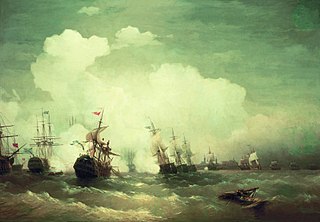
The naval Battle of Reval took place on 13 May [O.S. 2 May] 1790 during the Russo-Swedish War (1788–1790), off the port of Reval in the roadstead. This battle ended in an imposing Imperial Russian Navy's victory; it has been compared to the practice of running the gauntlet.
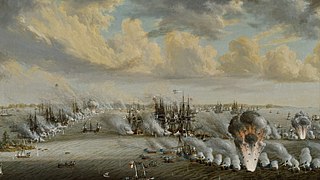
The Second Battle of Svensksund was a naval battle fought in the Gulf of Finland outside the present day city of Kotka on 9 and 10 July 1790. The Swedish naval forces dealt the Russian fleet a devastating defeat that brought an end to the Russo-Swedish War (1788–1790). The battle is the biggest Swedish naval victory and the largest naval battle ever in the Baltic Sea. It qualifies among the largest naval battles in history in terms of the number of vessels involved.
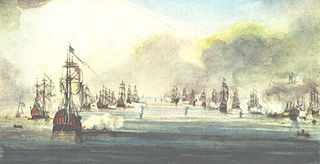
The Battle of Öland was a naval battle that took place on 26 July 1789 during the Russo-Swedish War (1788–90).

The First Battle of Svensksund, also known as the First Battle of Rochensalm from the Russian version of the Finnish: Ruotsinsalmi, was a naval battle fought in the Gulf of Finland in the Baltic Sea, outside the present-day city of Kotka, on August 24, 1789, during the Russo-Swedish War (1788–1790).
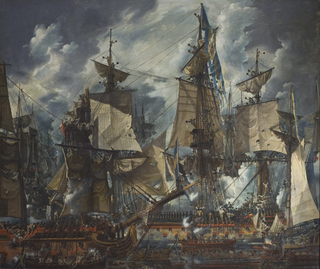
The Battle of Hogland was a naval battle that took place on 17 July [O.S. 6 July] 1788 during the Russo-Swedish War (1788–1790).

The Battle of Vyborg Bay was a naval battle fought between Russia and Sweden on 3 July 1790 in Vyborg Bay off the coast of Vyborg during the Russo-Swedish War (1788–1790). The Swedish Navy suffered heavy losses, losing seven ships of the line and three frigates, but Gustav III of Sweden eventually ensured a Swedish naval escape through a Russian naval blockade composed of units of the Baltic Fleet, commanded by Admiral Vasily Chichagov. British historians would later call the Battle of Vyborg Bay the "Baltic Trafalgar". The battle ranks among the world's largest historical naval battles and also among the most influential, as it introduced the naval battle concept of "firepower over mobility".

The Theatre War, Cowberry War, Cranberry War or Lingonberry War, was a brief war between Denmark–Norway and Sweden, starting on 24 September 1788, formally lasting until 9 July 1789. Although the decision to launch the attack was taken in Denmark, the majority of the attacking soldiers were Norwegians from the Norwegian army.
James Trevenen was an officer in the Royal Navy and the Imperial Russian Navy.

A turuma was a type of warship built for the Swedish archipelago fleet in the late 18th century. It was specifically developed for warfare in the Archipelago Sea and along the coasts of Svealand and Finland. The turuma was designed by the prolific naval architect Fredrik Henrik af Chapman for use in an area of mostly shallow waters and groups of islands and islets that extend from Stockholm all the way to the Gulf of Finland.
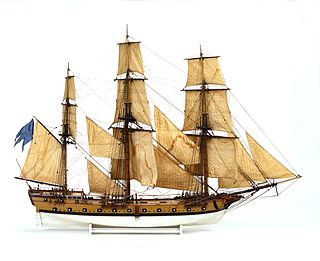
A hemmema was a type of warship built for the Swedish archipelago fleet and the Russian Baltic Fleet in the late 18th and early 19th centuries. The hemmema was initially developed for use against the Imperial Russian Navy in the Archipelago Sea and along the coasts of Svealand and Finland. It was designed by the prolific and innovative Swedish naval architect Fredrik Henrik af Chapman (1721–1808) in collaboration with Augustin Ehrensvärd (1710–1772), an artillery officer and later commander of the Swedish archipelago fleet. The hemmema was a specialized vessel for use in the shallow waters and narrow passages that surround the thousands of islands and islets extending from the Swedish capital of Stockholm into the Gulf of Finland.

The archipelago fleet, officially the "fleet of the army", was a maritime branch of the Swedish Armed Forces which existed between 1756 and 1823. Its purpose was to protect the coasts of Sweden, which was surrounded by a natural barrier of archipelagoes. Throughout its existence, the fleet was a largely independent arm of the Swedish Army, separate from the Swedish Navy, with the exception of a few years in the late 1760s. In a number of respects, it was a precursor of the Swedish Coastal Artillery and its coastal fleet.
HMS Ulla Fersen was a frigate of the Swedish Royal Navy, designed by Frederik H. Chapman, and launched in 1789. She served during the Russo-Swedish War (1788-1790), most notably at the Battle of Reval. British vessels twice detained her, once in 1798 and again in 1801, with the first event resulting in a major court case bearing on the meaning of neutrality. She was completely rebuilt in 1802, and lost in a storm in 1807.

The battle of Fredrikshamn was an attack by the Swedish archipelago fleet on their Russian counterparts near the town of Fredrikshamn during the Russo-Swedish War (1788–1790).

The Attack on Marstrand was a successful Dano-Norwegian siege of the Swedish town of Marstrand and Carlsten fortress which took place between July 10 and July 16, 1719 during the end of the Great Northern War.

The Battle of Björkösund took place on July 2–3, 1790 during Russo-Swedish War (1788–90), between Sweden and the Russian Empire.

The battles at Göta älv were a series of battles and sieges which took place in and around the Gothenburg area between 1717 and 1719, between the Swedish Empire and Denmark–Norway, during the Great Northern War.
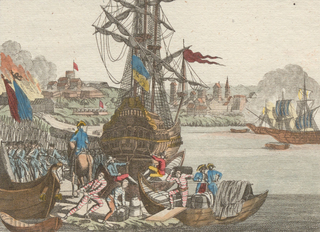
The Raid on Baltischport was a successful Swedish military operation during the Russo-Swedish war of 1788–1790 which targeted the small Estonian port of Paldiski. The Swedish force consisted of 2 frigates and 50-60 men led by Rudolf Cederström. The operation resulted in the Russian naval stores and war material located in Paldiski no longer being able to be used for the imminent mobilization.
















